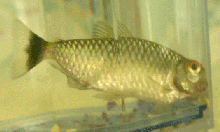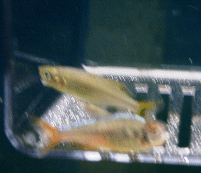|

817-293-1782
Looking for: Home
Accessories
Backgrounds
Breeders
Carbon
Chlorine remover
Cleaning Tools
Filter Cartridges and Media
Fishless Cycle
Medicine
Nets
Parts
Pond parts and supplies
Tests, pH, etc
Undergravel filters
--------------------------------------------
Pond Supplies
--------------------------------------------
Aquatics and Pet Articles
Aquarium Services - Local
Home - Everything Fishy
Pond Services - Local
Security
Shipping Info
Shopping Cart Errors
Warranty Info
Top of Page
|
|
Ordinary Septicemia, Dropsy, internal infections
Internal infections, septicemia and dropsy are considered 'gram-negative' infections. These have
few external symptoms, red streaks or swollen body being the main ones.,
but can be contagious and fatal.
Bruising, the appearance of blood under the skin, most often starting near the edge of the body
at fin "joints", is a good sign to quarantine the fish and start treatment with an antibiotic. If more than one
fish is ill, consult the ES symptom list. At this time I do not advocate minocycline because ES is very common, and there is the remote possibility that treating with minocycline might contribute to
bacterial resistance to tetracycline. Before ES entered my tropical fish population in about 1998 more medicines worked.
Since I am rather intolerant of deaths in customer tanks or my own, I recommend double checking all fish in the tank
before choosing any medicine. If in doubt I'd adjust the temperature whichever way the fish will
tolerate, (down to 71 or up to 83) and do 7 days with the whole tank on tetracycline.
On Dropsy: if the scales are all standing on end, I generally put the fish out of its misery.
A curled spine, causing the fish to appear ( shaped when viewed from above, is also caused by dropsy,
and may not respond to treatment. Quarantine and treat, or put the fish under. Humane execution: Sharp knife, chop
the head off being sure to sever the spinal cord quickly.
Click number to go to an order-capable page. Click product name for more info.
Treatments for Dropsy, Red Streaks / Septicemia:
* Gel-Tek Tetracycline
* Aquatrol Tetracycline 250 mg/10 ct
Treating a tank with non-edible dissolved tetracycline will give the aquarium water a brown bubbly appearance during
treatment, however, it will save your fish, and the water discoloration can be removed with carbon after treatment is completed.
2012 update - tetracycline alone no longer treats enteric septicemia, but it will crash your biological filter. See FritzZyme.. I combined it with Romet with some success on my last run.
1320 * 12/20/06 KanaPlex was used per label directions,
and the heaters were adjusted into normal range where ES can multiply if it is still present. All of the fish died with enteric septicemia symptoms, of
tetracycline resistant ES. So this is not a treatment for ES, although it may work on other diseases. It is in stock.
A second test group was held at temperatures over 84 degrees through all of 2006. When we lower the temp, we will see if
the TC resistant disease behaved as the original strain we observed, and died of 'old age'. Fingers crossed. It's hard watching the fish die.
2012 update. Not having found anything Kanaplex actually works on, we no longer carry it.
|
|
Enteric Septicemia
Enteric Septicemia is normally found in food-grade pond bred catfish, which I have ceased to eat after 7 years
of watching what it does to fish. It came to my attention in fall 1998, on 4 fish that came from P*tsmart.
They wiped out 1/3 of my stock after they died.
It has since become very widespread in tropicals, less common in goldfish or cichlids. The disease is dormant
and does not multiply or cause the fish to exhibit symptoms below 71 degrees or above 83 degrees. If temperatures
are outside the breeding range, the bacteria can still live in the brain, kidneys and liver of exposed fish for
200 days. I feed medicated food to all fish that were in the tank with an infected fish. Bottom feeders may ingest
waste from an infected fish and seem most prone to infection. Fish that consume part of a dead fish infected with
ES develop symptoms fastest of all, regardless of species. Successful treatment for the last 8 years has been
feeding medicated food. Tetra Anti-Bacterial was perfect, but was discontinued by the mfgr.
A gel form of tetracycline that can be mixed with food shows great promise,
since nothing but tetracycline seems to work, and it is in stock now.
Feed all fish exposed to the disease at least once a day for 7 to 10 days. Feed no pellets,
lettuce, treats, brine shrimp, etc. until the tetracycline treatment is over. (I tried 5 days in an elementary school tank,
and it almost stopped the deaths. 4 bottom feeders died afterward.)
Only a handful of fish develop solidly identifiable symptoms, but if half of the fish in the tank are
sick and symptoms vary, it might be ES. The disease seems to be very prevalent in the DFW area
of North Texas, especially on newly purchased fish. Treating with the wrong medicine wastes your money while the fish continue
to die. Quarantine new purchases - always. Control temp on quarantine tanks and feed or dose with tetracycline for 7 to 10 days.
Too short a treatment with the right drug results in a very dangerous fish, one carrying
an antibiotic-resistant form of ES, and it is still highly contagious to any new tankmates, so allow a generous quarantine period of 7 to 10 days.
Owing to the availability of sick fish around here, we continue to experiment with medicines
and post results as time permits.
Enteric Septicemia symptom list by type of fish, until I finally got my tanks cleared up.
Change temperature, up or down at the first sign. (see checklist at bottom for species temps)
Any fish exhibiting severe symptoms (not eating, mouth erosion) should be
removed from the community aquarium and put down humanely. Put the body in the trash,
not a sewer system that feeds a stream or lake. Feed the community tank tetracycline saturated food, and
any fish in isolation the medicated feed as well. Quarantine period on fish that had symptoms: at least 3 weeks
after apparent return to health. Fish that are not eating will not respond to treatment but would probably infect
the rest of the tank. Humanely putting them to death might be a good choice. All of my cichlids received medicated
food at the same time as the community tanks. None had exhibited symptoms, but algae eaters make good carriers.
- If the fish were small, such as neons, cardinals, rasboras, red eye tetras, or dwarf rainbowfish,
they would first exhibit darting and erratic swimming, followed by death, with the body appearing to have had the head bitten off.
- Dojos stop eating and appear to have 'sore mouths' before they die.
- Cory catfish stop eating, fins erode similar to fin rot, eyes may darken, and move around very
little for the 2 weeks or so prior to death. A day or 2 before death, red marks or sores may appear on albino catfish,
or be visible on the bellies of other cories. I could find no other markings on the dark catfish I have lost.
- Mollies that seem to die for no reason, very soon after purchase, are often carrying it. And new
news to me: so are their offspring. I didn't bother to dose the babies, moved them from a tank at 83 to a community tank,
and infected the community tank. Mollies hang out at the bottom, then die. Usually no visible symptoms.
- Fancy guppies exhibit dropsy symptoms, but other than poor apetite and bloating, no symptoms.
- Plecos don't seem to have visible symptoms, but if it is in the tank they usually carry
it invisibly for some time before they die. They eat the bodies of the dead fish, so are nearly always infected, but
maybe because of their size, they don't die as quickly, so there is more time for treatment. Assuming an exposed
pleco to be healthy can be a mess. Mine hid in the cave and I didn't know he was gone til he fell apart.
- Medium sized fish such as barbs or red tail sharks often exhibit flashing or darting behavior
in the hours just before they die, but have no visible symptoms. Darting: swimming rapidly from end to end in the
tank, even running into the end, etc.
- On a clown loach, no visible signs. No discoloration, no erosion around the mouth, not even
a red gill. Lack of desire to eat, great desire to hide from light, inability to control swimming pattern so it
tucks itself under a rock. Death.
- Large fish such as bala sharks (4 to 6 inch size) may exhibit red streaks on the body and gills,
but in a more all-over pattern than with septicemia resulting from an injury, for instance, all fins, and the belly
marked with red lines.
- Very large fish (7 inch gouramis) may exhibit dropsy for a period of a month or 2, be contagious
during most of that time and continue to eat. The dropsy will not respond to conventional treatments such as Maracyn-Two.
Dropsy symptoms on gouramis including hanging in the water, or resting on the tank bottom, head up, tail down,
and severe bloating. If the fish is still eating, isolate in a quarantine tank and feed medicated feed. It might
respond. (I put mine down days before finding a treatment for ES.)
 

|
Click for order page Tetracycline |
|